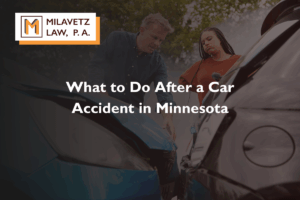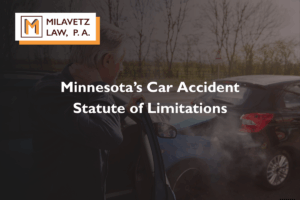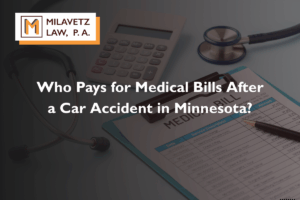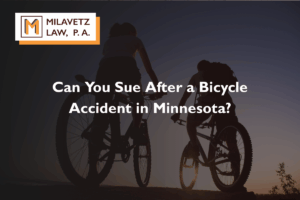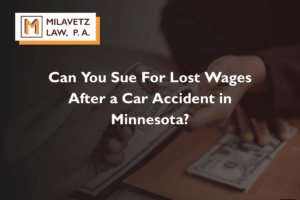Minnesota is a no-fault state for automobile accidents. Therefore, drivers must carry no-fault insurance, also known as personal injury protection, or PIP, to ensure coverage is available regardless of who is at fault in an accident.
Unfortunately, pursuing coverage in these cases can be complex, as various issues may arise when contending with the insurance provider. An experienced Minnesota car accident attorney at Milavetz Injury Law, P.A. can help you fight for the compensation you deserve.
Injured in a car accident? Contact us today

How Does Fault Apply in Minnesota Car Accidents?
Fault often plays a pivotal role in car accident cases because the at-fault driver’s insurance is typically responsible for payouts. However, Minnesota is a no-fault state for car accidents, meaning drivers must carry insurance coverage that pays for their own injuries.
However, PIP only covers certain out-of-pocket losses from a car accident, such as medical bills and lost wages. Thus, Minnesota’s no-fault law combines no-fault insurance with liability based on fault. This means that any damages from an accident not paid for by PIP coverage are the at-fault driver’s responsibility.
Minnesota Car Insurance Requirements
In Minnesota, drivers with licensed vehicles typically must carry these types of auto insurance:
- Liability: This covers claims to your policy from other drivers and damages to another’s vehicle—within stated limits—when you are the at-fault driver. Drivers must carry a minimum of $30,000 in coverage for injuries to one person, $60,000 for injuries to two or more individuals, and $10,000 for physical damage.
- Personal injury protection, or PIP: This offers basic economic loss coverage. Minnesota drivers must carry a minimum of $40,000 in coverage per person per accident, or $20,000 for medical and $20,000 for non-medical expenses.
- Uninsured motorist: This pays for your medical coverage after exhausting your personal injury protection benefits. It also covers situations where the other driver is at fault but uninsured. Drivers must carry a minimum of $25,000 in coverage for injuries to one person and $50,000 for injuries to two or more people.
- Underinsured motorist: This pays for medical claims covered by your policy and can be used on top of your personal injury protection benefits when the driver is at fault but doesn’t have enough coverage to pay your medical expenses. Drivers must carry a minimum of $25,000 in coverage for injuries to one person and $50,000 for injuries to two or more people.
What Is PIP Insurance?
Personal injury protection insurance, commonly called no-fault coverage, is required for all drivers in Minnesota. Unlike other types of coverage, PIP insurance isn’t dependent on fault. It offers basic economic loss benefits, extending to the following expenses:
- Medical expenses
- Lost income up to 85 percent of gross pay and up to $500 per week, and costs, such as childcare
- Replacement services, such as housekeeping
- Funeral expenses up to $2,000
Personal injury protection insurance excludes multiple types of damages that may be associated with an accident, including:
- Compensation for pain and suffering
- Property damage, including damage to your vehicle
What Medical Expenses Does PIP Cover in Minnesota?
Personal injury protection insurance in Minnesota covers any reasonable expenses for necessary medical care for injuries associated with a car accident. Coverage extends to:
- Medical services
- Medication
- Surgery
- Dental services
- Chiropractic services
- Transportation to medical care
- Rehabilitation
- Prosthetics
- Hospital stays
How Does PIP Coverage Work in Minnesota?
Minnesota’s no-fault insurance is often misunderstood, as many think it covers all losses in an accident, regardless of who is at fault. However, personal injury protection insurance solely applies to out-of-pocket expenses associated with injuries resulting from an accident.
If you are in a car accident in Minnesota, you’ll initially make a no-fault claim on your own personal injury protection insurance plan. If the expenses exceed your policy’s limit, you can file a claim against the other driver to hold them liable. The other driver’s liability coverage will cover the damages exceeding your personal injury protection coverage.
Minnesota Statute of Limitations and No-Fault Accidents
According to Minnesota Statutes Section 541.05, drivers must file their personal injury lawsuit within six years of the date of the incident.
If you wait too long, you cannot pursue a legal action for losses from your car accident. That’s why it’s crucial to seek legal guidance as soon as possible. A car accident lawyer can collect vital information by investigating your accident and gathering evidence before negotiating a settlement.
Minnesota no-fault claims must be made through the insurance company within six months of the accident, and drivers must do the following:
- Provide proof of expenses and submit bills to the insurance company as they come in
- Complete an application for benefits
- Submit to a medical examination if requested
How Can an Attorney Help with no-fault car accidents?
Unfortunately, personal injury protection insurance may not cover all costs associated with your car accident. In serious accident cases, your expenses may drastically exceed your coverage limits, leaving you with large bills.
In such cases, you may have to pursue compensation through the at-fault driver’s insurance.
These cases can quickly become complicated, requiring a skillful, thoughtful approach to secure the best results. Depending on the situation, you may have claims against third parties, such as a truck driver’s employer or auto manufacturer.
This is where an experienced attorney comes in. Your lawyer will navigate the legal system on your behalf, allowing you to focus on healing and recovery.
How Do You Pursue a Claim for a No-Fault Car Accident in Minnesota?
In the aftermath of a car accident, you should seek immediate medical assistance for your injuries. If possible, document your injuries with photos and collect the other driver’s information, including their insurance company’s name, policy number, license plate number, and contact information. Collect the names, addresses, and phone numbers of individuals who witnessed the accident.
Notify your insurance company as soon as possible. Many insurance companies require extensive paperwork to initiate the claim, so be prepared to submit documents such as:
Police records associated with the incident
- Medical records
- Mileage statements for transportation to and from appointments
- Income loss statements
Avoid providing a recorded statement to an insurance company without consulting an attorney first. Additionally, do not accept a settlement without seeking legal guidance. Doing either may jeopardize your right to full and fair compensation.
Consult the Skilled Attorneys at Milavetz Injury Law, P.A. for Help With Your Case
Minnesota’s no-fault insurance can be complicated, especially when coverage limits don’t account for all of your accident costs. In these cases, it’s best to seek help from an experienced personal injury attorney who can help you recover compensation.
At Milavetz Injury Law, P.A., we have over 50 years of experience and have recovered millions of dollars for our clients. Contact us to get started with a free, no-obligation consultation today.

